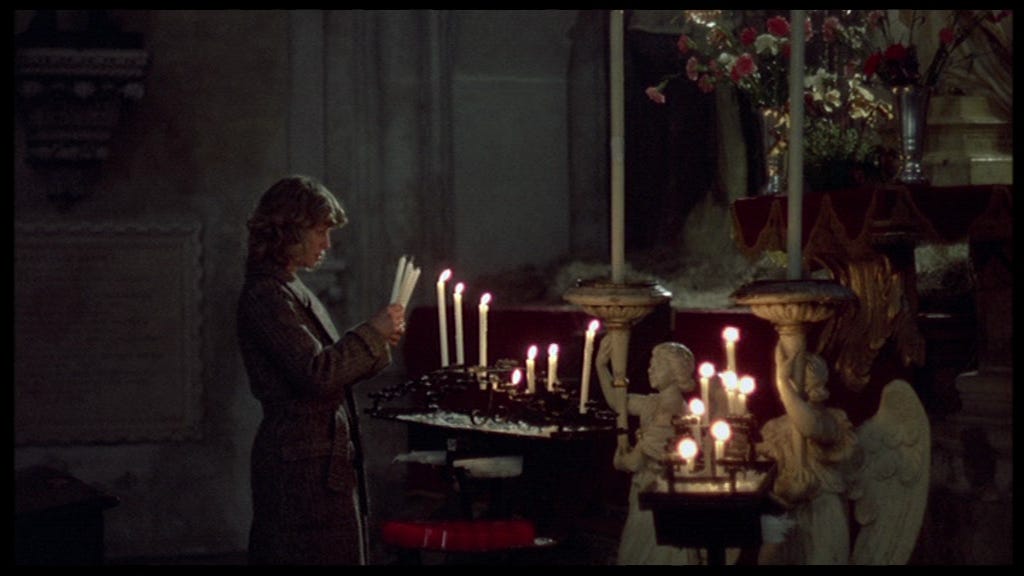The colours we associate with this film are a vibrant, lipstick red pvc mac, worn by a child. This glaring and fashionable coat stands out against all those natural greens of the grass and woodland near the house. Inside, the house is quiet. That image of a lit cigarette posed carelessly in the ashtray next to the remnants of Sunday lunch—rib of beef, congealing fat, dirty plates stacked to be dealt with later, littered with orange rinds and scraps, conveys the torpor of a lazy afternoon.
This is punctured by Christine (Sharon Williams) under the water in the pond, John (Donald Sutherland) lifting her out, the repetition of this image and his anguish, not a scream but horrible groans like a zombie and Laura’s (Julie Christie) scream cut with the drill of the church restoration in Venice. I hate to tell you this but Venice really is beautiful, a magical place, and it doesn’t feel dead though it ought to.



Something about their waving hair, his glen plaid suit and her tweed coat, in similar shades of brown and cream, their slender builds. I love this androgynous similarity between Christie and Sutherland here, how it feels of the moment (the early 70s) but also very modern, very now. I love how this continues in their much commented upon sex scene, their similar bodies side by side.



When Laura meets the sisters in the restaurant bathroom, Heather (Hilary Mason) tells her she has seen Christine. Laura swoons and has to be revived with Wendy’s (Clelia Matania) smelling salts, but then crashes across the lunch table in a dead faint, frisée lettuce and wine on cold marble, a scent reminiscent of Early Modern’s Celadon perfume, with its compelling fresh lettuce opening. While Laura feels joy at the idea of the veil being thin, John is sceptical.
Laura asks to stop at a church to pray and light a candle—I have done this in many places: Vienna, Pisa, Florence, Rome, Bologna, and of course in Venice. I would always rather pay to light up Caravaggio or to see Bernini’s Ecstasy of Saint Theresa but I often light a candle for a friend, especially if it is someone I worry about. But I also light candles for gratitude and love. I do this in these places because they often feel special, so filled with the silent desires of many. And because in Italy, all that art made for and about Christianity is the beauty that makes one drunk and it is the thing that made me understand Argento and other gialli: the reaction to all that beauty and blood, that often glamourous pain, the rolled eyes, the imploring look.
Don’t Look Now is a film I have only begun to appreciate for its subtlety and its frankness. That muted colour palette which is all about mourning, the flashes of red which feel deliberately borrowed from giallo, though this film predates Argento’s Suspiria. The weirdness that Roeg brings to the story; I suppose I must not be the first person to think of this film as a trilogy with The Man Who Fell to Earth (1976) and Bad Timing (1980), the films he directs in quick succession after Don’t Look Now, and which also deal with outsiders, with sex and desire, and how to inhabit your body.




The tenderness of the sex John and Laura have is striking, intercut with them dressing for dinner, and with shots of freesia, whisky, newsprint and magazines amongst the sheets. We can imagine the waxy fragrance of freesia alongside the forsythia that also stands in a vase in their suite: a woody floral, against the sweet burn of whisky.


Laura goes to tea with the sisters, for a kind of seance. “Nothing can take the place of the one that’s gone” says Heather. John waits in a bar alone, almost certainly drinking amaro, which is strong and herbal, and this also explains why he’s so drunk that he’s sick in the bathroom later on. Towards the end, Heather says she loves Venice because it’s so safe for her to walk, as someone visually impaired she can hear where she is by the stones, whereas her sister Wendy says it’s “a city in aspic” and aspic too is something edible, an way of making something jellied and preserved, but often associated with a kind of slimy texture, which is certainly also part of Venice’s textures and smells. In the film’s last moments, we are lost in the fog and the sound of Julie Christie’s high heeled boots ring out on stone, a sound that also appears in Possession and Guadagnino’s Suspiria, though those films often pair it with tossing hair and faintly maniacal laughter. And once more, there is red that is too red, and the city keeps its secrets.






